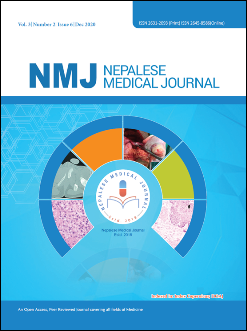Percutaneous Nephrolithotomy and Horseshoe Kidneys
DOI:
https://doi.org/10.3126/nmj.v3i2.33032Keywords:
Complications; Horseshoe kidney; Percutaneous nephrolithotomy; Stone clearanceAbstract
Introduction: The most common fusion anomaly, horseshoe kidney, is associated with vascular anomalies, malrotation, anterior displacement of the collecting system, superior insertion of ureter into the pelvis, and a higher rate of ureteropelvic junction obstruction; thus increasing the chances of nephrolithiasis. We present our experience with percutaneous nephrolithotomy in this anomaly.
Materials and Methods: A retrospective study of all the percutaneous nephrolithotomy performed by standard technique within four years at Bir Hospital was made. A comparison was made with similar cases with the anatomically normal location of the kidney. Intraoperative variables were recorded and postoperative stonefree status and complications were evaluated.
Results: Six hundred and twenty-seven patients out of 691 who had undergone percutaneous nephrolithotomy in this period were included. Patients with nephrolithiasis in horseshoe kidney were younger, the incidence of multiple stones was more; without full staghorn calculus and occupying fewer calyces. Upper pole access was easier, a stone clearance of 85.42 % was achieved with no major complications in the horseshoe kidney.
Conclusions: Percutaneous access and nephrolithotomy are safe in horseshoe kidney with a good stone clearance rate.
Downloads
Downloads
Published
How to Cite
Issue
Section
License
This license enables reusers to distribute, remix, adapt, and build upon the material in any medium or format, so long as attribution is given to the creator. The license allows for commercial use.
Copyright on any article published by Nepalese Medical Journal is retained by the author(s).
Authors grant Nepalese Medical Journal a license to publish the article and identify itself as the original publisher.
Authors also grant any third party the right to use the article freely as long as its integrity is maintained and its original authors, citation details and publisher are identified.




